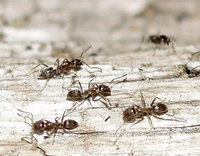Ant
|
|
| Revision as of 20:22, 12 Nov 2013 AcademicSysop2 (Talk | contribs) See also ← Go to previous diff |
Revision as of 22:01, 3 Dec 2023 AcademicSysop2 (Talk | contribs) Go to next diff → |
||
| Line 68: | Line 68: | ||
| - | {{AnimalClipart_insects}} | + | {{Animal_temp}} |
| - | + | ||
| - | == Animal Clipart == | + | |
| - | *[http://classroomclipart.com/cgi-bin/kids/imageFolio.cgi?direct=Clipart/Animals Animal Clipart] | + | |
Revision as of 22:01, 3 Dec 2023
| Ants | ||||||||||||
|---|---|---|---|---|---|---|---|---|---|---|---|---|
 Fire ants, Solenopsis invicta | ||||||||||||
| Scientific classification | ||||||||||||
|
The ants, one of the most successful groups of insects, are of particular interest because they form advanced colonies. They belong to the order Hymenoptera, and are close relatives of the sphecid wasp. The first known ants appeared sometime during the Cretaceous period, and it is believed that they evolved from the wasps that had appeared during the Jurassic period. They are physiologically distinguished mainly by having six legs, sharply elbowed antennae, and by having a bead-like pedicel formed from the first few abdominal segments, which in wasps are joined to the thorax. Ants are mostly wingless, which varies between individuals in a colony rather than between species.
| Contents |
Development
Ants develop by complete metamorphosis, passing through larval and pupal stages before they become adults. The larval stage is particularly helpless - for instance it lacks legs entirely - because it does not need to care for itself. The difference between queens and workers, and between different castes of workers when they exist, is determined by feeding in the larval stage. Food is given to the larvae by a process called trophallaxis in which an ant regurgitates food previously held in its crop for communal storage. This is also how adults distribute food amongst themselves. Larvae and pupae need to be kept at fairly constant temperatures to ensure proper development, and so are often moved around various brood chambers within the colony.
A new worker spends the first few days of its adult life caring for the queen and young. After that it graduates to digging and other nest work, and then to foraging and defense of the nest. These changes are fairly abrupt and define what are called temporal castes. In a few ants there are also physical castes - workers come in a spectrum of sizes, called minor, media, and major workers, the latter beginning foraging sooner. Often the larger ants will have disproportionately larger heads, and so stronger mandibles. Such individuals are sometimes called "soldier" ants because their stronger mandibles make them more effective in fighting other creatures, although they are still in fact worker ants and their "duties" typically do not vary greatly from the minor or median workers. In a few species the median workers have disappeared, creating a sharp divide and clear physical difference between the minors and majors.
Most of the common ant species breed in the same way. All ants in the colonies are females to begin with, but only the Queen and breeding females have the ability to mate. The male ants, called drones, along with the breeding females are born with wings, and do nothing throughout their life except eat, at least until the time for mating comes. At this time, all the breeding ants in the colony are carried outside (save for the queen) where other colonies of similar species are doing the same. Then, all the winged breeding ants take flight. Mating occurs in flight and the males die shortly afterward. The females that survive land and find a suitable place to begin a colony. There, they break off their own wings and begin to lay eggs, which they care for. The first workers to hatch are weak and smaller than later workers, but they begin to serve the colony immediately. They enlarge the nest, forage for food and care for the other eggs. This is how a new colony starts.Communication and behaviour
Ant communication is primarily through chemicals called pheromones. Because most ants spend their time in direct contact with the ground, these chemical messages are more developed than in other Hymenopterans. So, for instance, when a forager finds food on its way home (found typically through remembered landmarks and the position of the sun), it will leave a trail along the ground, which in a short time other ants will follow. When they return home they will reinforce the trail, bringing other ants, until the food is exhausted, after which the trail is not reinforced and so slowly dissipates. A crushed ant will emit an alarm pheromone, that in high concentration sends other ants nearby into an attack frenzy, and in lower concentration attracts them, while a few ants use what are called propaganda pheromones to confuse their enemies.
Like other insects, ants smell with their antennae, which are long and thin. These are fairly mobile, having a distinct elbow joint after an elongated first segment, and since they come in pairs they provide information about direction as well as intensity. Pheromones are also exchanged as compounds mixed in with the food interchanged in trophallaxis, giving the ants information about one another's health and nutrition. Ants can also detect what task group (e.g. foraging or nest maintenance) other ants belong to. Of special note, the queen produces a special pheromone without which the workers will begin raising new queens.
Ants attack and defend themselves by biting, and in many species, stinging, in both cases sometimes injecting chemicals into the target. Of special note here is formic acid.
Types
There is a great diversity among ants and their behaviors. See list of ant genera (alphabetical) for an alphabetical compendium of worldwide ant genera.
Of special note:
- Some of the more advanced ants are the army ants and driver ants, from South America and Africa respectively. Unlike most species which have permanent nests, army and driver ants do not form permanent nests, but instead alternate between nomadic stages and stages where the workers form a temporary nest (bivouac) out of their own bodies. Colonies reproduce either through nuptial flights as described above, or by fission, where a group of workers simply dig a new hole and raise new queens. Colony members are distinguished by smell, and other intruders are usually attacked, with notable exceptions.
- Some ants will raid the colonies of other ants, taking the pupae with them, which once hatched act as workers in the raider's colonies despite not being genetically related to the queen. A few species, such as the Amazon ants (e.g. Polyergus rufescens), have become utterly dependent on such slaves, to the point of being otherwise unable to feed themselves.
- Some ants, called honeypot ants, have special workers called repletes who simply store food for the rest of the colony, generally becoming immobile with greatly enlarged abdomens. In hot, dry places, even deserts, in Africa, North America and Australia where they live they are considered a great delicacy.
- Weaver ants (Oecophylla) build nest in trees by attaching leaves together, first pulling them together with bridges of workers and then sewing them together by pressing silk-producing larvae against them in alternation.
- Leafcutter ants (Atta and Acromyrmex) feed exclusively on a special fungus that lives only within their colonies. They continually collect leaves which they cut into tiny pieces for the fungus to grow on. These ants have several differently sized castes especially for cutting up the pieces they are supplied with into even smaller pieces.
Symbiotic relationships with ants
- Aphids secrete a sweet liquid called honeydew. Normally this is allowed to fall to the ground, but around ants it is kept for them to collect. The ants in turn keep predators away and will move the aphids around to better feeding locations.
- Myrmecophilous or ant-loving caterpillars (blues, coppers, or hairstreaks) are herded by the ants, led to feeding areas in the daytime and brought inside the ants nest at night. The caterpillars have a gland which secretes honeydew if the ants massage them.
- Some myrmecophagous (ant-eating) caterpillars secrete a pheromone which makes the ants think the larva is one of their own. The caterpillars will then be taken into the ants' nest where they can feed on the ant larvae.
- Allomerus decemarticulatus has developed a tripartite association with their host plant and a fungus in order to ambush their prey.
Humans and ants
Ants are useful for clearing out insect pests and aerating the soil. On the other hand, they can become annoyances when they invade homes, yards, gardens and fields. Carpenter ants damage wood by hollowing it out for nesting. Nests may be destroyed by tracing the ants' trails back to the nest, then pouring boiling water into it to kill the queen. (Killing individual ants is less than effective due to the secretion of pheromones mentioned above).
Some species, called killer ants, have a tendency to attack much larger animals during foraging or in defending their nests. Human attacks are rare, but the stings and bites can be quite painful and in large enough numbers can be disabling.
Ants have often been used in fables and children's stories to represent industriousness and cooperative effort, as well as aggressiveness and vindictiveness. In parts of Africa, ants are the messengers of the gods. Ant bites are often said to have curative properties.
Termites, sometimes called "white ants," are in fact not closely related to ants, though they have a somewhat similar social structure. They comprise the order Isoptera.
| List of Animals| Complete List of Animals by Letter | |
| List of Animals | Animal A| Animal B | Animal C | Animal D | Animal E | Animal F | Animal G | Animal H | Animal I | Animal J | Animal K | Animal L | Animal M | Animal N | Animal O | Animal P | Animal Q | Animal R | Animal S | Animal T | Animal U | Animal V | Animal W | Animal X | Animal Y | Animal Z |
|---|---|
| Animal Pictures and Photographs |
|
| Animal Videos and Sounds |
|


